1865-1879 - 8 Hours Labour - Coins and medals - Timeline and pictures
By Museum Victoria | Thursday, 22 November 2007
Victoria led the world in the struggle for better working conditions. The Eight-hour Day was first won in 1856. The aim was to divide the day into 8 hours work, 8 hours rest and 8 hours recreation.
Membership of Eight-hour Day committees was a prized honour and the members were given medals to mark their efforts in organising commemorative celebrations.
Paris delegation medal, 1867

In the second half of the 19th century, many Victorians participated in international exhibitions to promote export of their products. Sir Redmond Barry led a Victorian delegation to Paris in 1867. He was awarded this medal, the work of the French artist P J H Ponscarme, by the French Exhibition Commissioners.
Obverse - Laureate head of Napoleon III looking left, with the French legend NAPOLEON III EMPEREUR. The artist's name is below the head in tiny letters.
Reverse - Two cupids hold a plaque inscribed SIR REDMOND BARRY. The plaque rests on the head of the French Imperial eagle and is below a laurel wreath. Around it is the legend EXPOSITION UNIVERSELLE DE MDCCCLXVII A PARIS [The Universal Exhibition of 1867 at Paris], below is POUR SERVICES RENDU [for services rendered].
Melbourne Town Hall foundation stone medal, 1867

This medal is one of 26 made to mark the occasion of the laying of the foundation stone of the Melbourne Town Hall by the Duke of Edinburgh in 1867. Medals were issued to the Queen, mayor and councillors, architect, builders, town clerk and the Museum.
Obverse - Bust of His Royal Highness the Duke of Edinburgh facing left. Around it on a broad border is the inscription H.R.H. THE DUKE OF EDINBURGH, VISITED VICTORIA 1867.
Reverse - A view of the Melbourne Town Hall above the date, 29.NOV. Around it on a broad border is the inscription LAID FOUNDATION STONE OF TOWN HALL MELBOURNE. The medal maker's name, T. STOKES MELB. can be seen in small letters below the date.
Melbourne Regatta medal, 1868
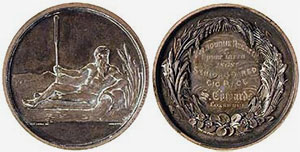
This is a silver medal made in London for the Melbourne Regatta of 1868. It features a classical representation of a River God, in this case to be understood as the Yarra, resting on an amphora from which the river begins to flow. The god holds an oar, representing rowing.
Obverse - River God reclining on a river bank holding an oar and resting on an amphora from which the Yarra river flows. The maker's name W.J.TAYLOR LONDON can be seen in small letters below the river. Taylor had tried to set up a mint in Melbourne in the early 1850s and retained links to the city.
Reverse - The inscription MELBOURNE REGATTA Upper Yarra 1868 SENIOR 4 OARED CIC RACE S. Edwards Coxswain.
Eight-hour Day medal, about 1870
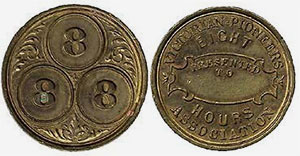
This small medal was manufactured as a presentation piece by the Eight Hours Committee of the Victorian Pioneers Association. It was never inscribed or presented. Its size suggests that it was designed to hang from a watch chain. Perhaps this was a trial piece in copper for a gold presentation piece.
Obverse - The numbers 888 in circles, representing 8 hours work, 8 hours recreation and 8 hours rest.
Reverse - The legend VICTORIAN PIONEERS ASSOCIATION EIGHT HOURS. In the centre is a plaque with the legend PRESENTED TO.
Medal won by Ferdinand von Mueller, 1870
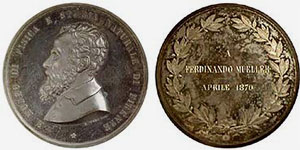
This silver medal was awarded to Baron Ferdinand von Mueller, Victorian Government Botanist by the Florence Natural History Museum in 1870. Mueller exchanged plant specimens with botanic gardens and museums around the world, and described thousands of Australian species.
Obverse - Bust of Galileo facing left. Around the legend R.MUSEO DI FISICI STORIA NATURALE DI FIRENZE.
Reverse - Inscribed within an olive wreath - A FERDINANDO MUELLER / APRILE 1870.
Melbourne Mint sovereign, 1872
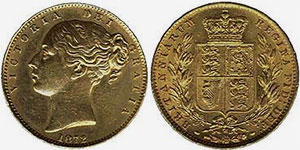
This is one of the fist gold sovereigns struck at the Melbourne Mint (the first and second coins were sent to London). These sovereigns were identical to coins struck at the Royal Mint in London and the Sydney Mint. Both the Melbourne and Sydney mints were set up as branches of the Royal Mint.
Obverse - Head of Queen Victoria facing left. Around it is the Latin legend VICTORIA DEI GRATIA [Victoria by the Grace of God], and the date 1872.
Reverse - Crowned arms of Great Britain within a wreath, around it is the legend BRITANNIARUM REGINA FID: DEF: [Queen of the Britons, Defender of the Faith]. Below the shield is a small letter 'M', the mint mark of the Melbourne Mint.
Christmas medal, 1872
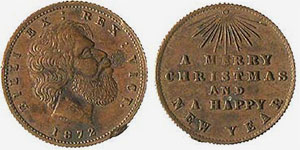
This little medal was made as a Christmas gift for 1872. It exists in two forms, one with the Christmas wish on one side and the Lord's Prayer on the other, and this one in which the Christmas wish is joined with a portrait of an Aboriginal man, Billi the ex-King of Victoria.
Obverse - Aboriginal portrait by a Jeweller and sculptor Julius Hogarth, around the legend BILLI EX REX VICT. 1872 [Billi ex King of Victoria]
Reverse - The legend A MERRY CHRISTMAS AND A HAPPY NEW YEAR
West Melbourne Bowling Club medal, 1873

The gold prize medal of the West Melbourne Bowling Club for their first Bowling Championship in 1873. The medal was made in gold and enamelled in red and blue - although most of the enamelling has been lost. It was won by William Aitken.
Obverse - Around the monogram WMBC (West Melbourne Bowling Club) is the inscription FIRST CHAMPION BOWLING TROPHY 1873.
Reverse - Around the monogram the inscription WILLIAM AITKEN.
Royal Humane Society swimming medal, 1874
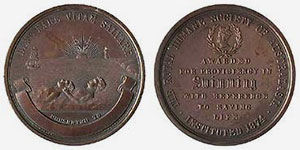
This is the Royal Humane Society of Victoria's medal for proficiency in swimming and life saving. The medal was struck by the Melbourne firm Stokes and Martin who donated this piece to the Melbourne Mint as an example of their medallic work.
Obverse - A proficient swimmer in the act of rescuing a man, in the background the rising sun, a sailing ship and a lighthouse. Above the swimmer is the legend in Latin BENE NARE VITAM SALVARE [To swim well, to save life]. Below him, above a scroll on which a recipient's name could be engraved, is the legend PRESENTED TO. The maker's name can be seen in tiny letters below the scroll.
Reverse - A small image of the crowned head of Queen Victoria within a wreath above the legend AWARDED FOR PROFICIENCY IN SWIMMING WITH REFERENCE TO SAVING LIFE. Around the edge is the legend THE ROYAL HUMANE SOCIETY OF AUSTRALASIA INSTITUTED 1874.
Exhibition commemorative medal, 1872
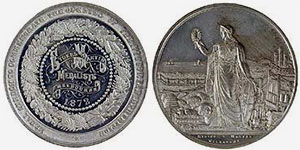
This medal commemorates the opening of the exhibition on 6 November 1872. It was struck by the Melbourne firm Stokes and Martin with a medal press they set up to demonstrate medal making at the exhibition.
Obverse - Around the edge on a broad rim is the legend MEDAL STRUCK TO COMMEMORATE THE OPENING OF THE VICTORIAN EXHIBITION. At the centre within a wreath is STOKES AND MARTIN MEDALISTS MELBOURNE 1872.
Reverse - A classical female figure representing the Colony of Victoria extending a victory wreath. Around her are the symbols of trade, industry and agriculture, the basis of Victoria's wealth. Below this in small letters is the maker's name STOKES AND MARTIN MELBOURNE.
Rifle Association prize medal, 1873
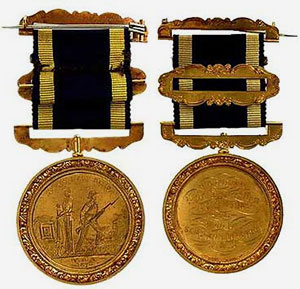
This is the 1873 gold prize medal of the Victorian Rifles Association. At that time the Rifles Association was closely linked to the Victorian Volunteer Defence Force, whose motto AUT PACE AUT BELLO appears above the riflemen engraved on the front of the medal.
Obverse - An engraving of two riflemen on a shooting range with a target in the left background. Above them is the legend AUT PECE AUT BELLO [both in peace and in war]. Below them is the legend VRA 1873 (Victorian Rifles Association).
Reverse - Engraved inscription VICTORIAN RIFLES ASSOCIATION GOLD MEDAL 1873 WON BY SERGANT LIMROCK SKA.
Photography prize medal, 1874

This is one of a group of exhibition prize medals won by the Melbourne photographer J Noone in the 1870s and 1880s. Most of his medals were won in Australia but he was also successful in London and at the Bengal Photographic Society exhibition of 1874.
Obverse - A woman, perhaps representing an Indian art muse, seated holding a book and a flower. The names of the artists, JS & AB Wyon can be seen in tiny letters on the seat.
Reverse - Inscribed within an olive wreath FOR WORKS OF ART TO J. NOONE 1874. Around this on a broad rim is the legend BENGAL PHOTOGRAPHIC SOCIETY.
Victorian Humane Society medal, 1874
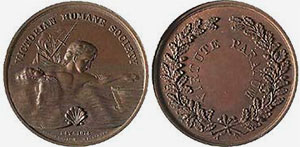
This medal was created by the Victorian Humane Society in 1874 as an award for those who saved lives after shipwreck. The medals were the work of Julius Hogarth, a Sydney silversmith and engraver who came to Melbourne hoping to get work at the Melbourne Mint. This particular medal was not awarded, but was collected by one of the first Victorian medal collectors to take an interest in local work, George McArthur of Maldon.
Obverse - A man stretches for the prow of an approaching boat with his left hand while supporting a child from drowning. In the background a burning ship sinks. Above this is the legend VICTORIAN HUMANE SOCIETY. Below is a shell with the artist Julius Hogarth's initials in tiny letters on either side. Below that ESTD. 1874 and the medal maker's name, STOKES AND MARTIN MELBOURNE.
Reverse - Within an oak wreath the Latin legend VIRTUTE PARATUM with space for the engraving of a name.
Board of Advice prize medal, c.1873 - 1910
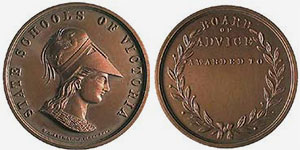
This is a State Schools of Victoria prize medal to be awarded by the regional Board of Advice. When free and compulsory education were first introduced in Victoria in 1873 the local management of schools in an area was through a Board of Advice, a forerunner of today's School Councils but each Board controlled a number of schools.
Obverse - Bust of Athena facing right and wearing a Corinthian helmet decorated with a griffin. Around the head is the legend STATE SCHOOLS OF VICTORIA and below in small letters is the name of the artist, E.A. ALTMANN, MELBOURNE.
Reverse - Within an olive wreath is the legend BOARD OF ADVICE AWARDED TO with a space below for the recipient's name to be inscribed.
Comunn na Feinne medal, 1877

This is a silver medal awarded to the Secretary of the Scottish Comunn na Feinne Society of Geelong, Mr JS Mackay in 1877. The Society marked its Australian identity by depicting an Aboriginal man and a Scotsman as supporters of its arms.
Obverse - Arms of the Commun na Feinne above a wreath of thistles supported by a Scotsman in kilt holding a sword and shield and an Aboriginal man holding a spear and boomerang.
Reverse - The inscription COMMUNN NA FEINNE to Mr. J.S. Mackay IN RECOGNITION of his Valuable Services as HON. SEC. Geelong Jany. 1877.
Silver medal for wine, 1878

This is a silver prize medal won at the Paris International Exhibition of 1878 by the Victorian winery St. Hubert's Vineyard Company. Success in international wine competitions was seen as a key marketing advantage to Victorian wine makers in the 19th century. St. Hubert's, in the Yarra Valley, was among the more successful wine makers.
Obverse - A laureate bust of France facing left, surrounded by the legend REPUBLIQUE FRANCAISE. Below the bust in small letters is the name of the artist who created the medal, JC Chaplain.
Reverse - Victory flying over the city of Paris holding a victor's wreath and a bugle. Below her runs a cupid holding aloft a plaque bearing the name of the prize winner St. HUBET VINEYARD COMPANY. Around this image is the legend EXPOSITION UNIVERSELLE INTERNATIONALE DE 1878 PARIS.
Ballarat Exhibition medal, 1878
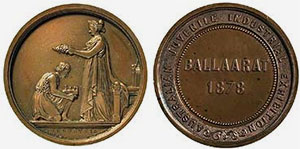
This is an un-issued bronze prize medal struck for the Australian Industrial Exhibition of 1878 held in Ballarat. It is the work of the Melbourne artist EA Altmann.
Obverse - A woman representing Ballarat standing before the exhibition building crowns a youth who kneels before her presenting a steam engine. Below is the word INDUSTRIA and the artist's name E.A. ALTMANN MELBOURNE.
Reverse - At the centre are the words BALLAARAT 1878 surrounded by AUSTRALIAN JUVENILE INDUSTRIAL EXHIBITION.
21st Birthday sale medal, 1878
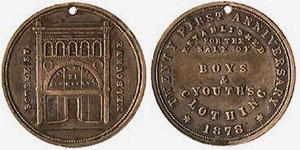
This is a small advertising medal made by the Monster Clothing Store of Bourke Street, Melbourne to celebrate their 21st year in business and to promote the sale of their boys and youths clothing.
Obverse - A view of the front of the shop with the name MONSTER CLOTHING COMPANY in the semicircular window above the door. The number 21 also appears in the window. This may have been their address or another reference to their 21st birthday. The address of the building BOURKE STREET MELBOURNE appears at the sides of the shop.
Reverse - The legend ESTABLISHED FOR THE SALE OF BOYS AND YOUTHS CLOTHING TWENTY FIRST ANNIVERSARY 1878.
Wesley College medal, 1879
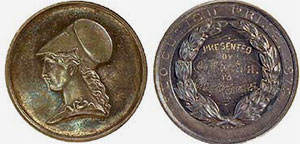
This is the Zupton Elocution prize medal in silver from Wesley College won by G De Lacy Evans in 1879.
Obverse - Head of Athens looking left and wearing a Corinthian helmet.
Reverse - Around a victor's wreath the inscription ELOCUTION PRIZE 1879. Within the wreath is the inscription PRESENTED BY G. ZUPTON TO G. DE LACY EVANS.
Sandhurst Exhibition medal, 1879
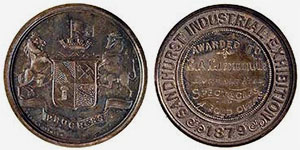
This is a prize medal from the Sandhurst Industrial Exhibition of 1879. It was won by EA Gosewincle won by his entry, a pair of fold over spectacles.
Obverse - Crowned arms supported by horses, below which is a ribbon with is the legend PROGRESS.
Reverse - This is a standard prize medal impressed with the legend SANDHURST INDUSTRIAL EXHIBITION 1879 AWARDED TO E.A. Gosewinkle EMERALD HILL SPECTACLES AND FOLDOVERS.



